Content
- 1 Where and on what do mushrooms grow?
- 2 Planting material
- 3 Planting mycelium and caring for mycelium
- 4 Harvesting
- 5 How to grow mushrooms at home (at home)
- 6 Useful properties of champignons
- 7 Conditions for growing mushrooms
- 8 Places for growing mushrooms
- 9 How to grow mushrooms in the garden?
- 10 Inventory for growing mushrooms
- 11 Substrate for growing mushrooms
- 12 Planting mushroom mycelium
- 13 Care for mushroom mycelium after planting
- 14 Harvesting champignons
- 15 Growing champignons - a business idea
- 16 Where mushrooms are grown
- 17 Growing mushrooms in the open field
- 18 How to get champignons in an apartment or house
- 19 How to collect champignons from a garden in an apartment
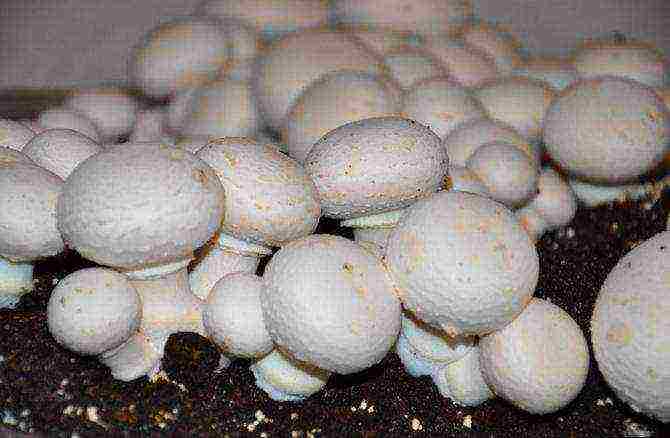
Champignons today have become the kind of mushroom that is available for growing at home. The time between planting the mycelium in the substrate and obtaining the first fruits is minimal. No special conditions are required for mushroom cultivation. It is enough just to provide a cool room with high air humidity. A basement or cellar is fine.
Champignons can be grown both for personal use and for sale. But it is important to know that the substrate for their growth when wet exudes a rather strong odor. It is not advisable to keep it in a residential area.
Where and on what do mushrooms grow?
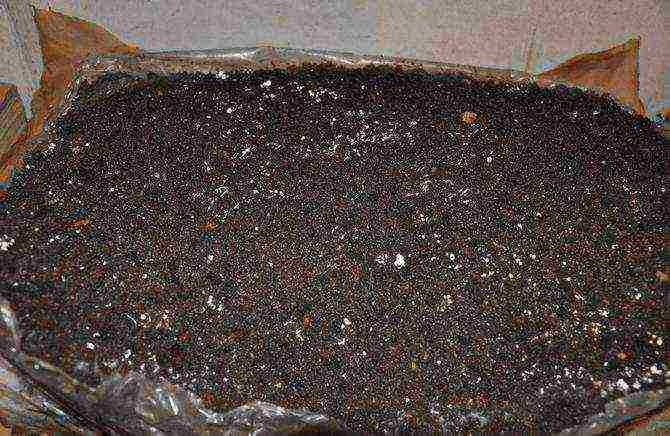
The very first and most important step in the successful cultivation of mushrooms is the correct preparation of the substrate. It must be prepared with high quality in compliance with all stages.
The mushroom substrate consists of:
- 25% compost (wheat and rye straw)
- 75% horse manure
There is experience in growing champignons based on chicken manure or cow dung, but you should not expect a high yield in this case.
The substrate is prepared in an open space on the street or in a well-ventilated room, since ammonia, carbon dioxide and moisture will be released during its fermentation. Additional additives per 100 kg of substrate are:
- 2 kg of urea
- 2 kg superphosphate
- 5 kg of chalk
- 8 kg of plaster
As a result, we get almost 300 kg of the finished substrate. With such a mass, you can fill a mycelium with an area of 3 square meters. m.
If a decision is made to prepare compost based on chicken manure, then the proportions will be as follows:
- 100 kg of straw
- 100 kg of litter
- 300 l of water
- Gypsum
- Alabaster
The procedure for preparing the substrate is as follows.
- Straw is soaked in a large, spacious container.
- The straw is laid in alternating layers with manure. There should be 3 layers of straw and 3 layers of manure.
- Straw in the process of laying in layers is moistened with water. Three layers of straw (100 kg) will take about 300 liters.
- During the laying of the layers, urea (2 kg) and superphosphate (0.5 kg) are gradually added in small portions.
- Mix thoroughly.
- Add chalk and the remainder of superphosphate, gypsum.
The resulting substrate is left to undergo the decay process. In this case, the temperature in the mixture will rise to 70 degrees. After 21 days, the compost will be completely ready for further use.
Planting material

When purchasing planting material, you should not save. Therefore, they acquire only the highest quality mycelium (mycelium). It must be grown under special laboratory conditions. Today mycelium producers present two types of planting material:
- Compost mycelium
- Grain mycelium
Grain mycelium is produced in plastic bags. Store it for about 6 months at a temperature of 0 to 4 degrees. Grain mycelium is used at the rate of 0.4 kg per 100 kg of substrate (mycelium area is 1 sq. M).
Compost mycelium is sold in glass containers. Its shelf life depends on the temperature. At zero degrees, it can last for about a year, but if the temperature is at 20 degrees, then the mycelium must be used within 3 weeks. Compost mycelium is used at the rate of 0.5 kg per 1 square meter of substrate. Its yield is much lower than that of grain.
A properly prepared substrate will surely spring when pressed. Before placing mycelium into it, it must undergo a pasteurization (heat treatment) process. After heating, the substrate cools down to 25 degrees. A mycelium of 1 square meter is laid with about 100 kg of substrate with a layer of about 30 cm.
Planting mycelium and caring for mycelium

They take a piece of mycelium the size of a chicken egg and burrow it into the substrate by about 5 cm. Each portion of mycelium is placed at a distance of 20 cm from each other. A staggered arrangement is used for landing.
Another method involves uniform distribution (dusting) of the entire surface of the substrate with mycelium. You also need to deepen by no more than 5 cm.
Further actions are to provide the necessary conditions for the engraftment and germination of the mycelium. Air humidity should be kept at around 90%. The substrate must also be kept moist at all times. To prevent it from drying out, the myceliums can be covered with sheets of paper. Watering the substrate is carried out through the paper. An important condition for mycelium engraftment is a constantly maintained substrate temperature at a level of 22 to 27 degrees. Any temperature deviations from the norm must be corrected immediately.
The germination time of the mycelium is approximately 7 to 14 days. After this period, the substrate needs to be sprinkled with a casing layer of soil about 3 cm. It is prepared independently from one part of sand and nine parts of peat. About 50 kg of casing layer will be consumed per square meter of mycelium.
The covering layer is kept on the substrate for three days, then the air temperature in the basement or cellar is reduced to 15-17 degrees. The cover soil is moistened with a spray bottle, and the room is constantly ventilated. Drafts are not allowed.
Harvesting
The process of self-cultivation of champignons in a cellar or basement is not too complicated and time-consuming. The period from planting to harvesting the first crop is 120 days. Only those mushrooms in which the plates under the cap are not yet visible are suitable for eating. Those mushrooms that are large are overripe, and dark brown plastics are forbidden to be used for food. They can cause poisoning.
The mushroom must not be cut, but carefully plucked with a twisting motion. The resulting depression is sprinkled with a covering substrate and moistened.
The mycelium will bear fruit for about 2 weeks. The number of crops harvested during this period is 7. Up to 14 kg of crop is harvested from one square of the area.
Growing mushrooms in bags
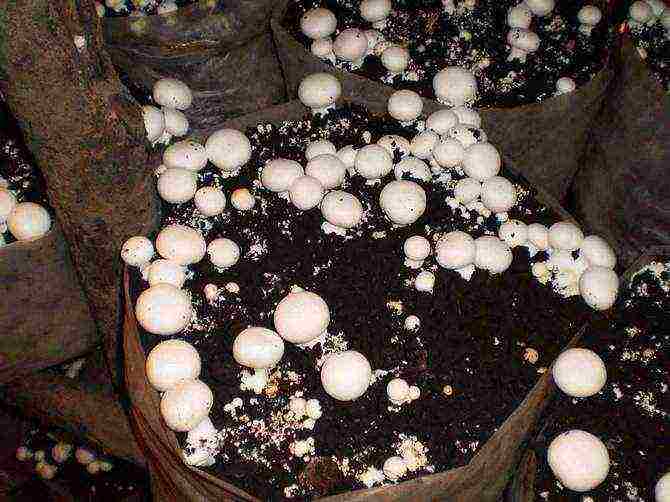
For growing champignons in large volumes for sale through retail chains I use polymer bags. This method has received its recognition in many countries. With its help, a large harvest is obtained.
- For the manufacture of the bag, a polymer film is used. The capacity of each bag varies from 25 to 35 kg.
- The bags should be of just such a volume so that it is convenient to work with them. In addition, the correct arrangement of the bags affects the number of mushrooms grown. They are usually staggered or parallel.
- So when installing bags with a diameter of about 0.4 m in a staggered arrangement, only 10% of the usable area will be lost, while their arbitrary installation gives losses of up to 20%.
- The height and width of the bags may vary. You need to proceed from their conditions and convenience of work, as well as the physical capabilities of the basement (cellar).
The method of growing mushrooms in bags is less costly, since they do not require specially mounted shelves or containers to place them. If it becomes necessary to use the area of the room as efficiently as possible, then a multi-tiered system can be created for the location of the bags. The advantage of this method also lies in the speed of dealing with emerging diseases or pests. The infected bag can be easily removed from healthy neighbors and destroyed, while if the mycelium is infected, it will have to remove its entire area entirely.
It is important to remember that growing mushrooms is a rather laborious process. If champignons are grown for sale, then it is impossible to do without the use of agricultural machinery to facilitate the work of the workers.
Experienced mushroom pickers can list a large number of methods they have tested for growing mushrooms on their own in a basement (cellar). Each method has its own advantages and disadvantages. The main thing is adherence to the cultivation technology, strict adherence to all instructions and requirements. The result is the achievement of the desired result and obtaining a rich harvest of mushrooms.
How to grow mushrooms at home (at home)
Mushrooms are not only a healthy and nutritious product, but also very tasty. Therefore, since ancient times, they have been used to prepare various dishes. Soups, stews, salads, pates, snacks and much more are made from mushrooms. Of course, you want to pamper yourself with such delicacies all year round. Then home-grown mushrooms come to the rescue. This option is suitable for those who do not like to go to the forest, stock up for the winter, or simply prefer to eat fresh. Since champignons are the most common mushrooms, in this article we will consider the question of how to grow champignons at home.
Useful properties of champignons
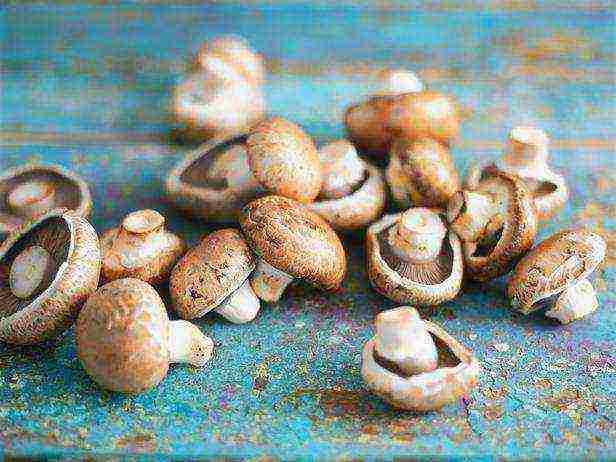
Excellent aroma, piquant taste - this is how you can describe champignons in a few words. However, these mushrooms are distinguished not only by their excellent taste, but also by useful properties. So, what are mushrooms rich in, what is their composition?
- Protein. An important component through which cells are renewed and built.
- Various amino acids. They have a beneficial effect on many functions of the human body, which include thought processes and memory. It turns out that if you know how to grow mushrooms at home, you can provide yourself with a year-round supply that makes our head work.
- Vitamins A, B, C, D.
- Phosphorus. Since mushrooms are rich in this element, they can easily replace fish if you don't like it.
Also, as an antiseptic, you can use the juice of these mushrooms to quickly heal cuts, wounds and ulcers. These are the most basic beneficial properties that champignons have.

Conditions for growing mushrooms
The technology for growing champignons presupposes the observance of some important conditions.
- Lack of sunlight.
- Moderate warmth. It is important to observe the temperature regime, the drops are extremely undesirable when growing mushrooms.
- Uniform and good ventilation.
- High humidity.
- A specific microclimate required at every stage of mushroom growth.
To meet these conditions and successfully grow mushrooms, special equipment may be required. We will return to this issue later, but for now we will consider the places most suitable for growing mushrooms.
Places for growing mushrooms
As mentioned above, several conditions must be met in order to achieve successful year-round mushroom cultivation. At home, a basement, cellar, balcony or garage can be a suitable place, while mushrooms are planted in boxes or pallets.
Champignons are very unpretentious mushrooms, so they can be grown even outdoors in garden beds or in greenhouses. But in this case, it will be possible to harvest the crop only in the warm season.
How to grow champignons in the garden?
It is good to grow mushrooms in the garden, since they will be in the fresh air. But outdoors, it is more difficult to create the necessary conditions for mushrooms, and this must be taken into account, so it is better to cover them with a tarpaulin or make a canopy, a greenhouse. It will be great if there is the most humid and shaded place on your site. Compost is spread on the garden bed, and then everything is done the same as when growing mushrooms at home.
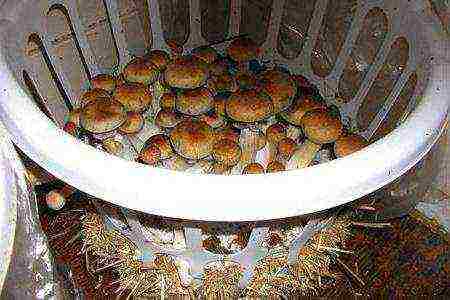
Inventory for growing mushrooms
- Mushroom mushrooms. Of course, nothing will work without her. Therefore, you first need to decide where to buy the mushroom mycelium.
- A place to grow. The options have already been listed above. Most often, the basement is preferred, since it is there that it is easiest to create suitable conditions.
- Shelving. They can be anything: iron or wooden. It doesn't matter: the boxes of mushrooms won't be heavy.
- Capacities where mushrooms will be planted. For this, you can use, for example, boxes, pallets, baskets.
- Fans. Suitable for ventilation and temperature reduction.
- Hygrometer. Needed to monitor the humidity in the room. The optimal indicator is from 50 to 80 percent.
- Thermometer for temperature control. It should be between 12 and 20 degrees Celsius.
- Substrate. Let's consider how to compose it correctly.
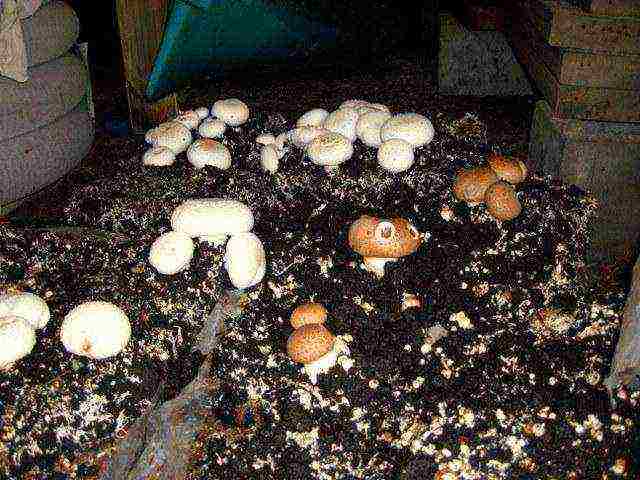
Substrate for growing mushrooms
This is considered the most difficult stage in mushroom cultivation. A poor harvest may result if the substrate is not compiled correctly. So how should you compose it?
For the substrate, you will need mushroom compost, which includes: manure and straw from rye or wheat. Horse manure will yield high yields, but cow or bird droppings can also be used. It will be a plus if you add fallen non-rotten leaves and some organic waste, since mushrooms are very "gluttonous". Also, beet tops, sunflower seed shells, urea, chalk, gypsum, bone meal, bran and superphosphate are used as nutritional components. When compiling the substrate, the following proportion is observed: 75% manure and 25% compost.
How to grow champignons at home in a small area of 1.5 square meters? You can use the following compost formula.
- Straw - 50 kilograms.
- Urea and superphosphate - 1 kilogram.
- Gypsum - 4 kilograms.
- Chalk - 2.5 kilograms.
- Manure - 150 kilograms.
In total, a little more than 200 kilograms of substrate will turn out.
The straw must first be soaked for a day, then lay it in layers with manure. It is better to moisten each layer of straw with urea and superphosphate. Then everything is mixed and other nutritional components are already introduced. The substrate should now be infused for about 20 days. We can talk about complete readiness when the unpleasant smell of ammonia disappears.
It is not necessary to stick to this formula, there are other recipes for how to grow mushrooms at home.
When compiling the substrate, you need to be prepared for the fermentation process to begin, which is accompanied by the specific smells of ammonia and carbon dioxide, so it is better to do this not indoors, but in the fresh air. The compost should be covered with a canopy to hide it from rain and sunlight.
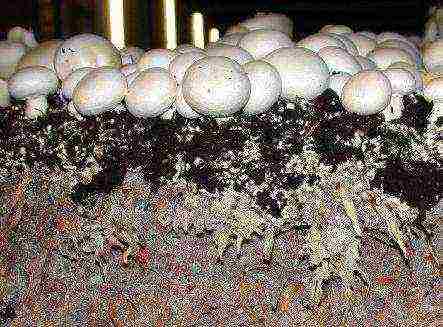
Planting mushroom mycelium
At home, it is better to grow sterile myceliums obtained in laboratories. They take root more easily and reproduce faster. Mushroom mushrooms come in different varieties, one type is consumed more, the other less. So, for 1 square meter of substrate, 400 grams of grain mycelium will be required, and manure - 500 grams.
When you have decided on the amount of consumables and bought it, you can proceed to direct disembarkation. First, you should measure the temperature of the substrate, the most optimal for the mushroom mycelium is considered to be a mark of about 25 degrees.
So how to grow champignon mushrooms? The holes are recommended to be staggered at a distance of 20-30 centimeters from each other. The mycelium must be broken into small pieces and planted to a depth of 5 centimeters. The grain variety can be simply laid on the surface.
Care for mushroom mycelium after planting
After replanting the mycelium, the conditions mentioned above must be observed. This is high humidity and moderate heat. Moreover, these conditions must be met not only indoors, but also in the substrate. To keep it constantly moist, you can cover it with a newspaper and spray it from time to time - then the compost will not be dry.
After about a week, the mycelium will begin to grow, then the substrate should be sprinkled with soil on top by 3-4 centimeters. The technology for growing mushrooms suggests that during this period it is necessary to slightly lower the temperature of the substrate to about 20 degrees, and indoors - to 12-17 degrees. Do not forget about good ventilation in the room, however, drafts should not be allowed. In principle, that's all the care for the mycelium.

Harvesting champignons
It is not enough to know how to grow champignons at home; harvesting also has its own nuances.
With good care, champignons bear fruit in waves for up to two months, during which time you can get mushrooms many times. You can start harvesting the first crop after 30 days.
Champignons are not cut like wild mushrooms, but are twisted out of the substrate. Then the empty hole is sprinkled with earth and moistened to create conditions for the emergence of a new crop. Not all mushrooms are picked, but only "ripe" ones - these are those that have a stretched white film under the cap that connects the leg and the edges of the cap, and the plate has a pale pink color. It is not recommended to eat champignons with brown plates. If the film is broken, then the mushroom is considered old. This should not be allowed, as it greatly depletes the mycelium.
Growing champignons - a business idea
The cultivation of champignons was popular in the 18th century in European countries and not only, most often in Italy, France, America, Germany, Sweden, England and Belgium. In Russia, home production of these mushrooms began only in the 19th century, because our forests are already rich in edible gifts of nature.
Today mushroom cultivation is a profitable business. If you make simple mathematical calculations, then in one year you can get up to 6 harvests. Of course, there will be additional costs for equipment, electricity and heating. But in general, you can get a good income from the sale of champignons, you just need to know to whom to constantly sell the resulting crop.
It is not surprising that today such a niche as mushroom cultivation is already occupied by entrepreneurs, because these mushrooms bear fruit abundantly, they are easy to grow, and the necessary raw materials (in fact, waste) can be purchased almost for free. Of course, you can try to break into this business, but you will have to work hard to get a solid profit from it in the first months.
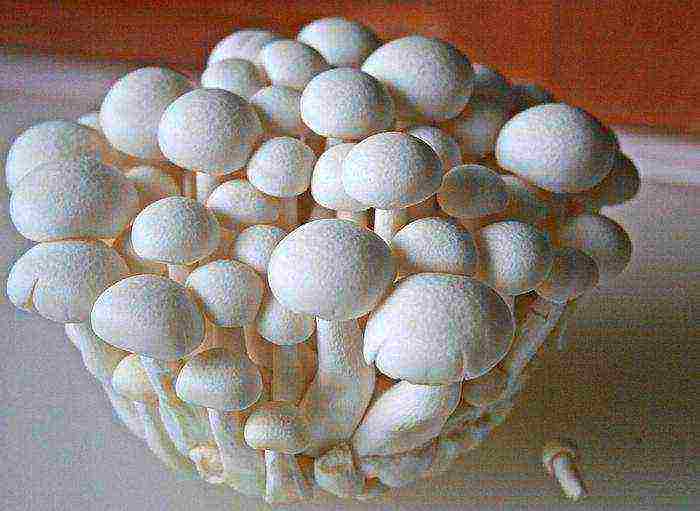
Now you know how to grow mushrooms at home, and what equipment is required for this. You can start production on a large scale, or you can plant these mushrooms for yourself, for your soul, to feast on them all year round. In any case, growing champignons is not difficult and even interesting.

Good day, dear readers. Mushrooms are an important component of human nutrition. Every tenth loves "quiet hunting" in the autumn forest, others buy fruit bodies in supermarkets, and still others grow products at home. So today we will talk about how to grow mushrooms at home.
Immediately, we note that this is a troublesome business, compared to the cultivation of oyster mushrooms in bags, for example. But on the other hand, the return on the harvest is profitable, and for some people growing mushrooms has become so profitable that it has become a regular business.
Where mushrooms are grown
Before asking how to grow champignon mushrooms at home, let's analyze the availability of a place available for cultivation. It is better to grow mushrooms in a basement, cellar or other room with the ability to maintain a constant positive temperature.
Is it possible to grow mushrooms outdoors in a garden area? Of course it is possible, but it strongly depends on climatic conditions and is subject to temperature changes and other external influences. Read a brief information on growing in a garden at the end of the article.
For own consumption, it is not so important where the mushrooms are grown, but for sale it is better to equip a permanent warm room.

Mushroom growers advise to divide the room into two halves with different thermal indicators:
- Room for incubating mycelium in a substrate with a temperature of 23-25 degrees Celsius.
- Premises for forcing the fruiting bodies of mushrooms - 16-18 degrees.
To prepare the soil substrate, you will need a concreted area or a large container for mixing and preparing the components.
It should be noted that the necessary components of the premises are the supply and exhaust openings, with the help of which the temperature and humidity conditions in the room are regulated. The ventilation ducts are tightened with a metal mesh that prevents the entry of animals and insects. Heaters to raise the heat level and sprayers to humidify the air should be taken care of.
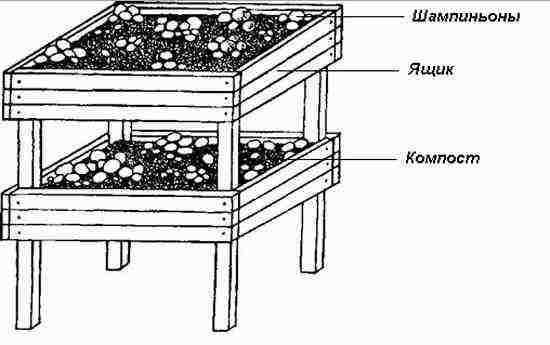
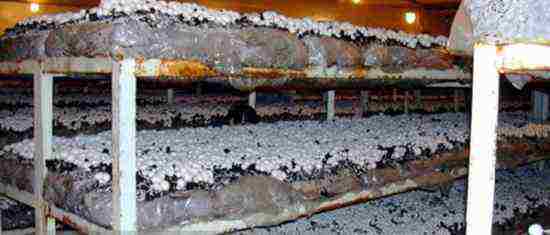
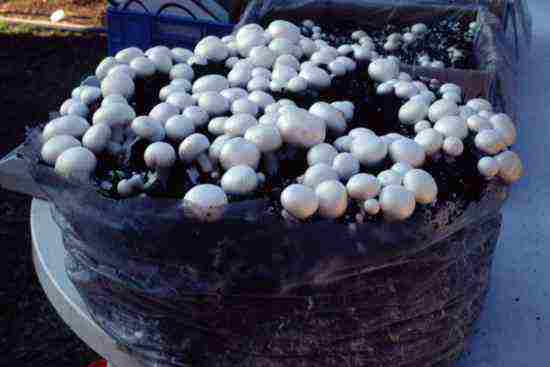
For growing champignons, boxes 10-15 centimeters high are used, which will be transferred from one room to another. First, they are installed in a warm room until the mycelium takes root, and then they are rearranged on racks for distilling fruit bodies in a cool room.
Preparing the soil for planting champignons
The composition of the soil for growing mushrooms is important, therefore, how to properly prepare the substrate, we will devote a separate chapter. First, compost is prepared from straw with horse or cow manure, chicken droppings.
Composting should be done in an open area under a canopy that protects the pile from sun and rain. The weight ratio of manure and straw is 4: 1.
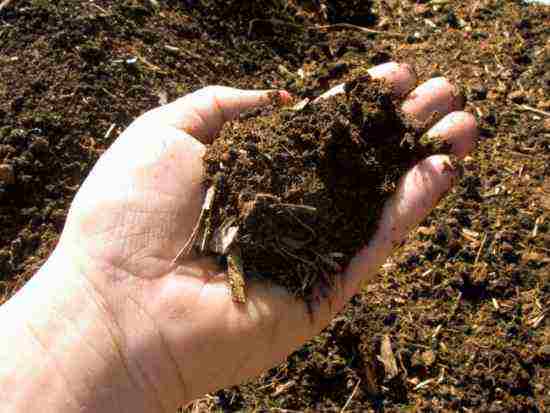
Let's describe the composting process step by step:
- We soak the straw for a day in warm, at 20-25 degrees, water.
- We stack manure and straw in layers. You will need to make at least four layers.
- During the laying process, each layer is additionally moistened at the rate of 40 liters per 10 kilograms of straw. Pre-dissolve 50 grams of urea and 200 grams of superphosphate in water.
- We mix the components.
- Add gypsum - 800 grams per 10 kg of straw.
- Mix again.
- Add superphosphate - 150 grams.
- Stir a third time.
- We fall asleep 500 grams of chalk (also for 10 kg of straw).
- We mix completely.
Recommended stack sizes: 1.5 meters in height, length and width. On the third or fourth day, a thermal reaction will begin, and the food will heat up to 60-75 degrees Celsius. The preparation process will last three to four weeks, depending on the ambient temperature, after which the substrate is inoculated.

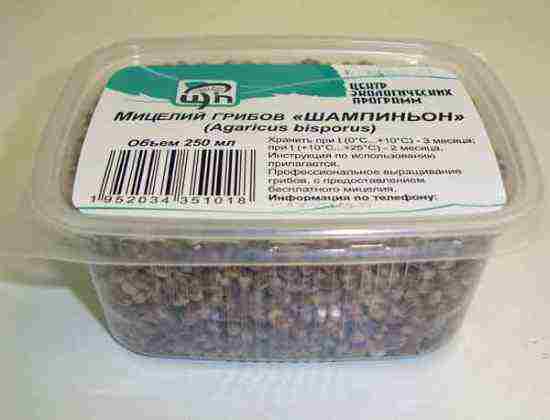
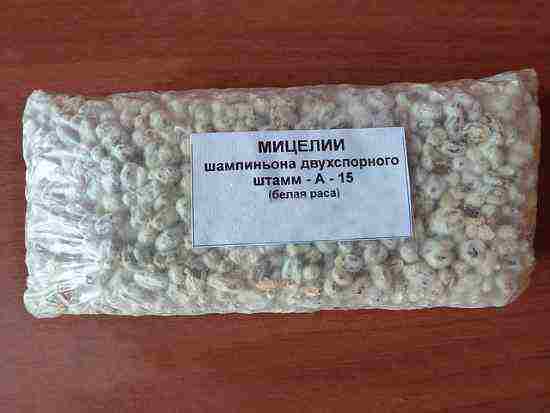
Inoculation
Before infecting the substrate with champignon mycelium, it is laid out in prepared boxes, and they, in turn, are brought into a warm room: a warm room, a greenhouse or other suitable room.
Before purchasing mycelium, calculate the required amount, the rate of application per square meter of substrate:
- grain - 400 grams;
- compost - 500.
If you have compost mycelium, then we do this:
- In the prepared and laid soil, we make holes with a diameter of five centimeters.
- We arrange the holes in a checkerboard pattern with an interval of 20 centimeters. The depth of the holes is 5-7 centimeters with a total thickness of the compost layer of 10-15 centimeters.
- We put the mycelium in the holes and sprinkle it with compost on top.
Grain mycelium is simply scattered over the surface of the substrate; on top it is worth lightly sprinkling the surface with warm water.
After a few days, white filaments of mycelium will appear on the surface of the substrate. This means that the inoculation was successful and the mycelium began to grow. At this moment, it should be covered with a layer of soil of 3-4 centimeters. The composition of the soil is as follows:
- peat - 5 parts;
- lime - 1 part;
- sod land - 4 parts.
Forcing champignons
The next stage of mushroom cultivation is the forcing of fruit bodies. 3-5 days after filling the mycelium with soil, the temperature in the room should be reduced to 13-17 degrees or the boxes should be taken to another room. Fresh compost is brought into the incubation room for the continuity of the process.
Now two points become important:
- Ventilation of the room so that there is no mustiness.
- Constant spraying to avoid drying out of the substrate and mycelium.
Harvesting champignon mushrooms
Three to four months after rearranging the boxes in the forcing room, the collection of mushroom fruiting bodies begins. The yield of the crop occurs in "waves", of which there can be 5-8 pieces, while the main share of mushrooms falls on the first 2-3 harvests, up to 70 percent.
You need to collect unopened caps with a diameter of 4-6 centimeters, old mushrooms are less tasty and are less digested by the human body. A distinctive feature of fresh champignon is a thin film on the bottom of the mushroom head.
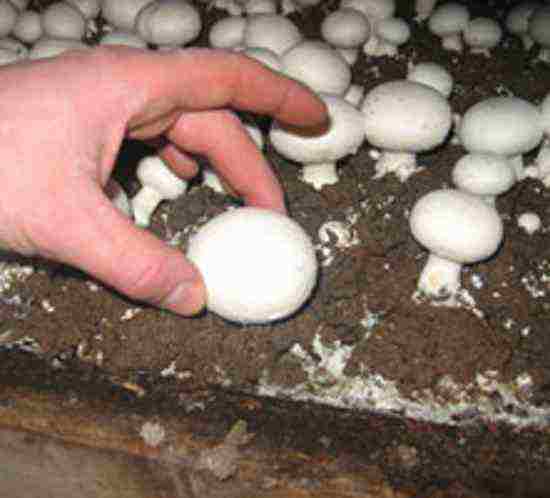
When assembling, the leg is not cut off, but unscrewed. The holes formed in this case should be immediately covered with earth and slightly moistened with a sprayer. This process will accelerate the emergence of new fruiting bodies.
In the future, new waves are collected 1-2 times a week, depending on the intensity of growth. The total yield per square meter reaches 5-10 kilograms.
Growing mushrooms in the open field
For personal consumption, you can lay a champignon garden directly on the garden plot. We will describe this process step by step:
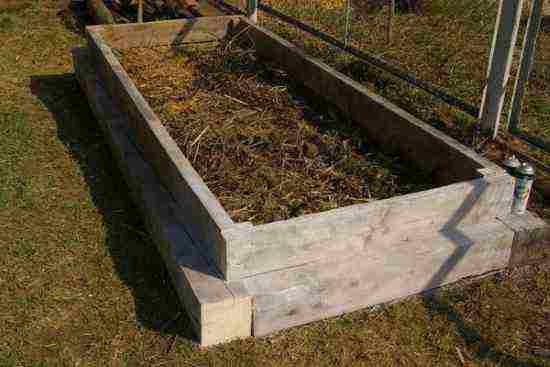
- We build a bed-box in the garden. The dimensions of the box depend on the personal preferences of the owner, but we recommend using narrow "mittlider" ridges 45 centimeters wide, the length is arbitrary.
- In a garden bed 15-20 centimeters high, we lay compost, which is prepared according to the method described above.
- We inoculate the mushroom mycelium into the garden bed. The embedment depth is 10-15 centimeters, the hole pitch is 20 centimeters.
- We cover the surface of the bed with a film for better engraftment.
- After the growth of the mycelium, we remove the film and cover it with a layer of earth, its composition is also described above.
- Harvesting as it ripens.
This method gives a lower yield, but once planted mushrooms can be harvested for several years from one garden. To do this, it is worth laying a new compost mixture on top of the soil every spring.
Mushroom crops can not only be harvested in the forest, but also obtained by themselves - by growing in a basement, greenhouse, garage and other places.
Many people today are interested in how to grow mushrooms in an apartment or a country house, and whether this is possible in principle - for example, in a pantry. We will learn about growing these delicious mushrooms in a home environment: preparing the soil, choosing mycelium, cultivating and harvesting mature specimens.
How to get champignons in an apartment or house
Although the process of obtaining a champignon crop in a city apartment or rural house is quite troublesome and requires a lot of patience, it is quite possible to grow it at home. The main thing is to observe the technology and adhere to the relevant recommendations of experienced mushroom pickers.
Preparing the soil for mushrooms
Mushroom compost is 80 percent horse manure, the rest is straw or wheat grain. If you cannot find horse manure, we replace it with cow or chicken droppings, however, you will collect a smaller crop.
Preparation of compost for mushrooms is done as follows:
- We find a level place in the fresh air, where the compost will not be flooded with rain or dried by the sun. You can also prepare it in a room or closet, the main thing is that it is well ventilated, otherwise the apartment will smell like ammonia and there will be a lack of oxygen.
- We stock up on a centner of straw raw materials (wheat grain), urea (two kg), chalk powder (five kg), gypsum (eight kg) and superphosphate (two kg). Together with 50 kg of horse manure, there will be so much compost that it will be enough for three square meters of myceliums.
When using chicken manure, in addition to straw, you will need 8 kilos of gypsum, three hundred liters of water and a centner of droppings. Instead of chalk powder and superphosphate, we use alabaster.
- Soak raw straw in water by placing it in a large bowl. After 24 hours, we put straw and manure in layers in a high ridge (about 3-4 layers of each).
- When laying the straw, moisten it with water, add urea and superphosphate. We leave the ridge to ripen.
- Every five days (5 times in total) we stir the ridge to start the combustion. The ridge should be about one and a half meters long and high, and 1.2 meters wide.
Before planting mushrooms, we check the soil for readiness. Press down on it: good compost will be slightly elastic. Cool the soil to 25 ° C and pour it into the planting containers in a layer no more than 30 cm thick.
Planting mushroom mycelium
Before growing champignons in an apartment, we choose the most suitable planting material.
- Grain mycelium... Stored in a plastic bag at a temperature of less than 4 ° C for no longer than six months. For planting, you need about 400 g of such mycelium per square meter of soil.
- Compost mycelium... Easily stored at a temperature of no more than 20 ° C for twenty days, at 0 degrees - 12 months. For planting, you will need 500 grams for each square of compost.
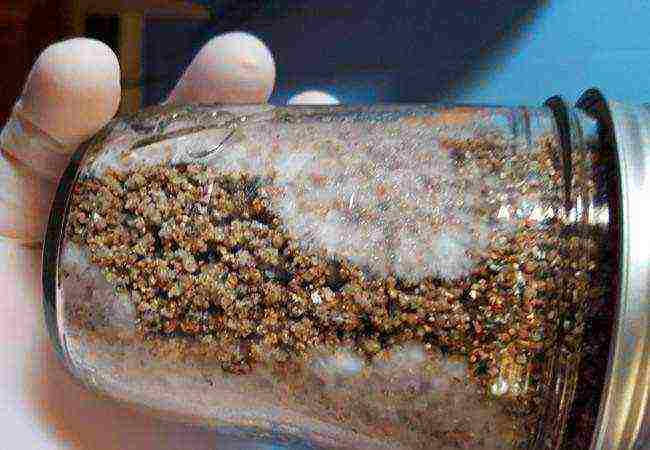 Planting mushroom mycelium
Planting mushroom mycelium
To plant mushroom "seeds", lift the soil with a stick and put a handful of compost mycelium the size of an egg, placing the plantings in a checkerboard pattern, at a distance of 25-30 cm from each other.
Sprinkle the grain mycelium over the soil and sprinkle it with a five centimeter layer of compost.
If you need a high yield, we use grain mycelium, if you want less trouble - compost, the main thing is that the planting material is grown in laboratory conditions.
Mushroom planting care
To grow a decent harvest of champignons, the following conditions and care procedures are important.
Optimum humidity for growing mushrooms
The main condition for a good mushroom harvest is a normal moisture level - from 75 to 90 percent. To keep the substrate moist, cover the containers with any breathable material such as paper or burlap.
We spray them with water, preventing the liquid from seeping into the mycelium.
Temperature regime
The temperature inside the compost should be between 21-26 ° C. If it has risen, we ventilate the pantry.
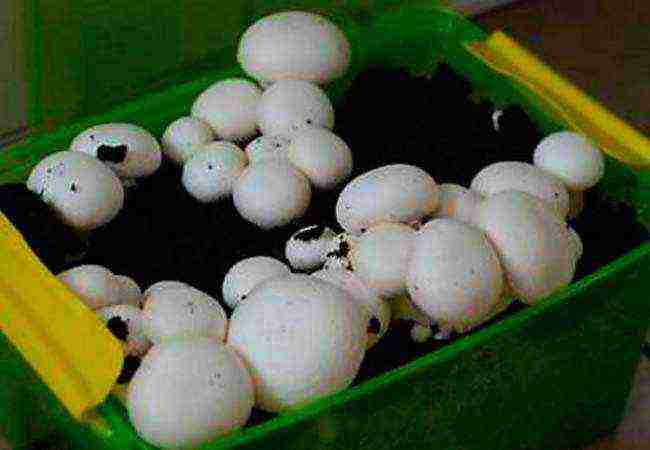 How to get champignons in an apartment or house
How to get champignons in an apartment or house
Covering mycelium with soil
After 7-14 days, we prepare the substrate for the cover of the growing mycelium: we mix peat (9 parts) with one part of chalk. Second option: mix 4 parts of garden soil with 9 parts of peat and 1 part of chalk. For each "square" of the substrate, you need almost 50 kg of soil.
5 days after filling the soil mixture, we maintain the air temperature at about 17 ° C - no more.
We regularly moisten the bedding by spraying so that water does not penetrate into the soil, and ventilate the pantry, avoiding drafts.
How to collect champignons from a garden in an apartment
The reward for the hassle will be a good harvest, which must be harvested while the legs and edge of the hats are connected with a film. Instances with darkened plates are not suitable for food.
When collecting, we do not cut off, but unscrew the mushrooms, subsequently filling the holes with a covering soil mixture.
From the moment of harvest to the next harvest, it takes about 7 days.
One square meter of mushroom plantings is capable of producing from 5 to 12 kilograms of selected champignons.
Now you know how to grow mushrooms in an apartment, prepare a substrate for planting, choose mycelium and take care of a mushroom plantation. It remains only to be patient and strictly follow the recommendations for growing mushrooms at home.


